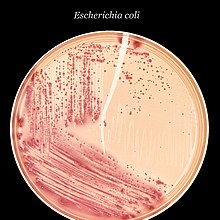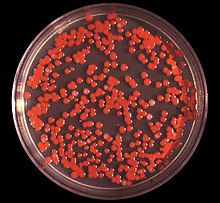Microorganism culture

A microorganism culture results from the cultivation of microorganisms . The organisms grow through cell division in a culture medium that is suitable for them under controlled conditions, including a certain temperature and the presence or absence of oxygen . The type of organism used can be examined more closely using a microorganism culture. For example, a bacterial culture can be isolated from a sample in order to detect the bacteria it contains. This can refer to pathogens , but also to microorganisms that z. B. are naturally contained in a soil sample.
Cultures of microorganisms are used for many purposes. They are used in biotechnological production processes to e.g. B. to produce enzymes or vitamins ; in pharmaceutical biotechnology to e.g. B. to produce antibiotics , or in genetic engineering to create genetically modified organisms with specific properties.
In microbiology, a distinction is made between various culture techniques, of which the pure culture, the enrichment culture, the liquid culture and the culture on "solid" gel culture media are among the most important. There is also the cell culture area , which describes cultures of eukaryotic cells , i.e. animal or plant cells.
Pure culture
The goal of a pure culture is the growth of a clone from a particular organism to the exclusion of any individuals of other species or strains of organisms. A pure culture is also known as an axenic culture . The undesirable other organisms are called contaminants. Only in pure culture can standardized conditions be maintained and microorganisms examined with regard to their metabolic and physiological properties.
Enrichment culture
An enrichment culture offers growth conditions which are more favorable for a certain microorganism or a certain physiological group of microorganisms than for other microorganisms, with the aim of enriching them selectively while the growth of other organisms is slower or is inhibited. For example, anaerobic microorganisms can be specifically enriched in soil samples by using culture techniques that exclude the access of oxygen. Conditions are also created in the activated sludge basin of a biological sewage treatment plant that promote the growth of certain bacteria (e.g. that of Zoogloea sp.) And suppress that of other species. The principle of enrichment culture was developed independently by Martinus Willem Beijerinck and Sergei Nikolajewitsch Winogradski .
Liquid culture
In liquid cultures, microorganisms are cultivated in liquid nutrient media . The culture vessels are usually shaken automatically for growth-promoting ventilation (supply of oxygen). The vessels used, such as. B. Erlenmeyer flasks contain so-called baffles, inwardly directed protrusions to promote mixing. A liquid culture offers the advantage that it can be produced in larger quantities in order to use it, for example, in biotechnological production processes in a bioreactor . Small amounts of a liquid culture are also used, mostly in test tubes - also known as culture tubes in microbiology. They are used to quantify microorganisms using the “Most Probable Number” method (see MPN method ) or to test for certain metabolic performance of microorganisms in order to identify them as part of a “ colorful series ”.
Culture on agar media
A gel nutrient medium is created by adding a gelling (“solidifying”) substance to a culture medium that does not serve as a food source for the respective organism. The most commonly used gelling agent is agar (agar-agar), other solidifying agents are gelatin , gelrite and silica gel .
The organisms can be made to grow and multiply on the surface of the gel or inside it. The advantage of a culture on or in gel agar media is that most microorganisms cannot move on or in it, so that they form colonies on or in gel agar media . This is used to produce pure cultures, to obtain smaller amounts of microorganisms for studies and to quantify microorganisms.
Fractionated dilution smear

The fractional dilution smear is a special technique for applying microbial samples to the gelled medium in order to obtain isolated colonies that are needed for identification. Here, the infected inoculation loop is slalomed over the surface of the nutrient medium without damaging it and interrupted twice in order to sterilize the inoculation loop and start a new fraction. The end of the previous fraction is crossed once with the inoculation loop and a new fraction is formed like a slalom.
In the picture you can still see the trace of the inoculation loop as well as the effect of the dilution smear: In the first fraction at the bottom left everything is still overgrown by a large colony; this alone is unsuitable for identification of most microorganisms. In the second fraction on the top left you can already see single colonies, in the last fraction on the right side there are only single colonies. Individual colonies arise from a single cell or from a few cells of the same type that have detached from the inoculation loop there.
Under certain circumstances, especially when using special differential culture media, individual colonies can enable the microorganism to be identified based on shape, surface, border and color. Escherichia coli can be recognized e.g. B. on endo agar on spherical single colonies that are dark purple-red and have a metallic sheen. However, precise identification is only possible through further, sometimes complex, tests and, in difficult cases, through particularly expensive and time-consuming DNA analyzes.
By taking a sample from a single colony and isolating it further by spreading it on an agar medium, a pure culture of a microorganism can be obtained and this can be propagated further. If this procedure assumes an individual, the pure culture is a clone .
Prokaryote culture
In microbiology, the culture of prokaryotes plays an important role, i.e. the culture of bacteria (Bacteria) and archaea (Archaea). The presented microbiological culture techniques can be applied to both domains , i.e. bacteria and archaea, but in practice bacteria cultures are used more often, since many archaea belong to the extremophiles, i.e. are adapted to extreme biotopes . In medical microbiology , the diagnostic bacterial culture is of particular importance in order to detect and identify pathogens and to examine their properties (e.g. sensitivity to antibiotics ). The number of colony-forming units in a sample can be determined using a surface-viable count .
Culture of eukaryotic cells
A cell culture is understood to mean the cultivation of animal or plant cells - i.e. cells of eukaryotes - in a nutrient medium outside the organism .

Although these are also eukaryotic cells, yeast and mold are cultivated differently than animal or plant cells. They belong to the objects of investigation in microbiology and their cultures are similar to those of bacteria, i. H. they too form colonies on solid nutrient media.
Virus culture
Viruses need a suitable host cell for their reproduction, so they can only be reproduced in a culture of the host cells. The appropriate eukaryotic cells are therefore used for viruses, and the appropriate bacterial cells for bacteriophages .
See also
- Culture medium (culture medium, culture medium)
- Liquid culture media ("bouillon")
- Solid culture media
- Selective medium
- Differential medium
- Inoculation (inoculation, inoculation of culture media with bacteria and other microorganisms)
- Incubator (incubator)
- Anaerobic technology
- Bioreactor (fermenter)
swell
literature
- Susan Isaac, David Jennings: Culture of Microorganisms . Spektrum Akad. Verlag, Heidelberg 1996, ISBN 3-8274-0049-X . Translation of the English language edition with the title Microbial culture .
- Eckhard Bast: Microbiological Methods: An Introduction to Basic Working Techniques . 2nd Edition. Spektrum Akademischer Verlag GmbH, Heidelberg / Berlin 2001, ISBN 978-3-8274-1072-6 .
Individual evidence
- ↑ a b c d Eckhard Bast: Microbiological methods: An introduction to basic work techniques . 2nd Edition. Spektrum Akademischer Verlag GmbH, Heidelberg / Berlin 2001, ISBN 978-3-8274-1072-6 .
- ^ A b c Hans G. Schlegel, Christiane Zaborosch: General microbiology . 7th edition. Thieme Verlag, Stuttgart / New York 1992, ISBN 3-13-444607-3 .
- ↑ Roland Süßmuth, Jürgen Eberspächer, Rainer Haag, Wolfgang Springer: Biochemical-microbiological internship . 1st edition. Thieme Verlag, Stuttgart / New York 1987, ISBN 3-13-685901-4 .

